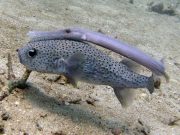There are three species of trumpetfish recorded world-wide, closely related to the pipefish, seahorses and cornetfishes. You'll often see this fish while diving Koh Lanta.
Trumpetfishes are generally slow-moving, active in the day-time, and often found singly around the reef, occasionally in pairs. This is a poorly studied fish, with little known about their behaviour.
Trumpetfish cleverly employ two distinct methods to catch their prey of small fish and crustaceans.
The first method is as an ambush predator, lying in wait close to hard corals or beside/within gorgonian fan corals to stalk prey or patiently wait for a target to appear. They often approach their prey in a vertical, head down position.
The second hunting method is to swim very close to another, larger fish, such as a grouper or pufferfish, or even a hawksbill turtle, allowing it to approach and attack its unsuspecting prey.
When darting in to catch prey, the extendable mouth can be rapidly expanded outward, and the mouth widened almost to the same diameter as the body. This process creates huge suction which rapidly draws the prey into the mouth.
The trumpetfish family name 'Aulostomus' is from the Greek: aulos, meaning flute, and stoma, meaning mouth, although this common name 'Flutemouth' is actually more often used to refer to Cornetfish (Fistulariidae).
1 species found on this page.



